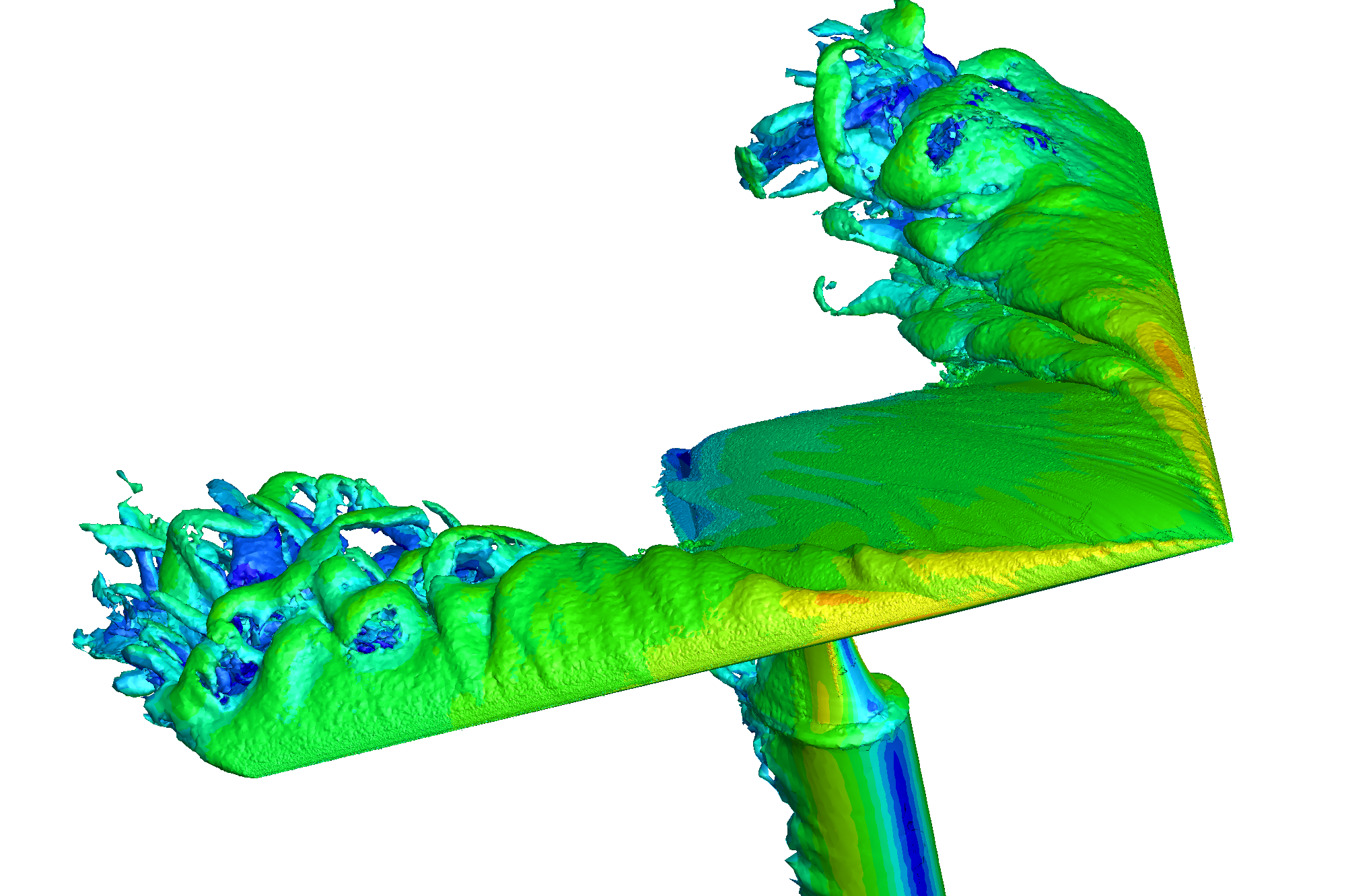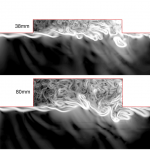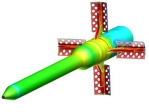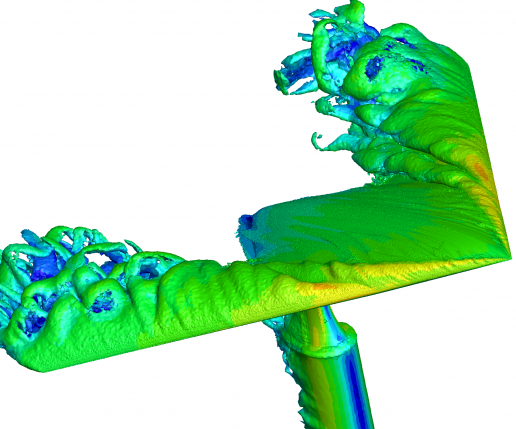Computational Aerodynamic Modeling for Flight Dynamics Simulation of Ram-Air Parachutes
Aerodynamic models were generated to simulate the flight dynamics of a parafoil wing with and without trailing-edge deflection. The airfoil was provided by the Natick Soldier Research, Development, and Engineering Center (NSRDEC) and was based on a modified Clark-Y with a flat lower surface used as the cut pattern for drop tested systems. The wing is characterized with an aspect ratio of two and zero anhedral angle. Several derivatives of this wing geometry were tested in the Subsonic Wind Tunnel (SWT) of United States Air Force Academy (USAFA).
These wings have either an open or closed inlet, a round or flat leading edge (for closed wings) and are with and without the trailing edge deflection. The flat leading edge wings consist of a straight line connecting the wing’s lower surface to the upper surface. The TE deflection is approximately 45◦ as measured from the flat lower surface. For convenience, these wings were named S R, B R, S F , B F , in which S and B denote straight and bent trailing edges; R and F indicate round and flat leading edges.
Canard-Wing Interference Effects on the Flight Characteristics of a Transonic Passenger Aircraft
Effects of canard wing interference on the flight characteristics of a civilian transonic cruiser are examined. The aircraft is an unconventional design concept with no historical data. The flight characteristics of the aircraft are predicted using aerodynamic models in the form of look-up tables, generated using high-fidelity computational fluid dynamics simulations and a potential ow solver. These tables contain longitudinal and lateral force and moment coefficients for different combinations of angle of attack, side-slip angle, and control surface deflections. Dynamic damping derivatives are calculated from time-accurate simulations of the aircraft models oscillating in pitch, roll, and yaw direction and using a linear regression estimation method. The static simulations are performed at a Mach number of 0.117, as reported in wind tunnel experiments, and for two different canard positions using an overset grid approach. The aerodynamic tables include canard deflections of [-30, -10, 0, 10] at angles of attack from -4 to 30 degrees. Lateral coefficients are simulated at sideslip angles of -6 and 6 degrees as well. The dynamic simulations are performed for aircraft oscillations about mean angles of attack between zero to ten degrees with a motion frequency of 1Hz and amplitude of 0.5 degrees. The predicted aerodynamic data are then compared with those measured in wind tunnel experiments and calculated from the potential ow solver. The results show that both static and dynamic predictions match reasonably well with experiments for the range of angles considered.Continue reading→
Virtual Flight Testing of High Performance Fighter Aircraft Using High-Resolution CFD
This article discusses the current phase of a multi-year development effort to provide a computational method for determining static and dynamic stability and control characteristics of USAF high-performance fighter aircraft. The focus of this work is on the virtual flight test capability achieved by incorporating a pilot model, the F-16 flight control system (FLCS), and six degree-of-freedom (6-DoF) motion computation into the CFD maneuver simulation. Flight test maneuvers were performed in a virtual environment by using CFD to determine the forces and moments acting upon the aircraft and allowing the aircraft to respond as governed by the pilot model, FLCS, and 6-DoF. Virtual flight test simulations were accomplished with a full-scale F-16C aircraft using unstructured, viscous, overset grids and Cobalt with a MATLAB interface. Virtual flight test maneuver response is shown to compare well to validated, flight-test corrected data. This marriage of capabilities is rolled into a software suite known to the developers as COMSAC, which stands for COMputational Stability And Control.Continue reading→
Evaluation of Dynamic Pressure-Sensitive Paint for Improved Analysis of Cavity Flows and CFD Validation
Cavity flows have been the subject of aerodynamic research since the early days of high-speed aircraft with internal store carriage in the 1950s. Low observability design requirements for current combat aircraft has renewed the interest in this field. The presence of an open cavity, such as a weapon or undercarriage bay, exposed to a high-speed grazing flow can result in severe pressure fluctuations. These pressure fluctuations can reach intensities of up to 165dB SPL and may cause damage to both the aircraft and to any sensitive components within the bay. Results for this study were generated using an existing generic rectangular planform cavity wind tunnel model, designated as M219/1. This small scale model was the forerunner for the more widely known larger scale M219 generic cavity model.
Numerical simulations were performed for two geometries, the 38mm and 80mm deep cavities, at a freestream Mach number of 0.80. In order to capture the unsteady flow behaviour in the cavity, a time accurate detached eddy simulation (DES) model was run which uses Reynolds averaged Navier-Stokes (RANS) near to the wall to reduce computational cost and a large eddy simulation (LES) model in the separated flow region far from the walls.Continue reading→
Simulation Validation of Static and Forced Motion Flow Physics of a Canard Configured Transcruiser
Computational Fluid Dynamics(CFD) simulations are anticipated to become the primary tool in the design of modern commercial and military aircraft. Specifically, CFD has become reliable enough to detect the source of undesirable flight characteristics experienced in the flight testing. However, CFD techniques are subject to inaccuracies and must be validated and evaluated on the basis of experimental data. Researchers at the US Air Force Academy have been using Cobalt to predict static and forced motion aerodynamic responses of a canard configured TransCRuiser named the TCR. In the process, they have also examined and validated the use of Cobalt’s Overset method to simulate canard deflections.Continue reading→
F-18C JDAM Weapon Separation
The F-18 JDAM weapon separation problem originated in 1998 as a technical challenge to the CFD community. Our original work on this and the problem definition is documented in AIAA 1999-0122 A Solution on the F-18C for Store Separation Simulation using Cobalt60. In 2007, the first version of the Cobalt Overset module was used to simulate the flow. The same job inputs were used for the V6 and V7 solutions discussed below.Continue reading→
Argus Missile Fin Deployment
The Argus Missile is a ground penetrating sensor device that is dropped from an aircraft. The streamlined missile deploys 4 paddles to slow and stabilize on its descent. A computational analysis of this action is challenging due to the tight gaps between the folded paddles and missile body, the deployment action, and the motion of the sliding locking ring.Continue reading→
Wing Aileron Flap
A test case of the F-15 wing, aileron and flap was used to demonstrate the application of the Cobalt v7.0 Overset Module to moving control surfaces. In this type of application, the motion is prescribed and the limits of the grid motion are known ahead of time. There is also a very tight space between the control surfaces and the wing where the code must create a good hole-cut throughout the motion cycle. This geometry also presents the overlap of three grids at the intersection of the wing, aileron, and flap. All these qualities combine to present a realistic application to be able to simulate.Continue reading→
Prediction and Validation of Aerodynamic Characteristics for a Generic UCAV Configuration with Trailing-Edge Flaps

Illustrating the vortex dominated flow over the SACCON at an angle of attack of 16 degrees. DDES-SARC turbulence model used. Isosurface of vorticity magnitude shown colored by velocity magnitude.
UCAVs present significant nonlinear aerodynamic characteristics with respect to angle of attack, control surface deflections and frequency of motion even at low angles of attack, which makes the task of predicting the aerodynamic characteristics very complicated. This application focuses on using Cobalt to predict and validate the aerodynamic static and dynamic forces on the Stability and Control Configuration (SACCON) uninhabitated combat air vehicle (UCAV) geometry with the addition of two trailing edge control surfaces on each wing. The work primarily looks at the effects of angle of attack for the control surfaces both undeflected and deflected, and the effects of sideslip and dynamic pitch and yaw motions for the control surfaces undeflected.Continue reading→
Stability and Control Characteristics of High Performance Aircraft

A-10 aircraft with centerline fuel tank used in System Identification (SID) of CFD. Isosurface of vorticity.
The motivation for this work is to initially use CFD so that flight test and wind tunnel resources can be applied where they are needed the most. The combination of Cobalt with the resources of High Performance Computation program of the DoD allow for more in-depth simulations and quick turnaround. This work is a good step toward the end goal of ‘flying’ an aircraft using Cobalt.
During this work, the A-10 with centerline fuel tank was simulated in order to compare CFD and SID of CFD versus wind tunnel. Developing a SID model can be done in minutes and once validated, it can Continue reading→












